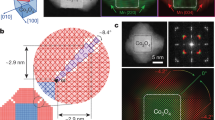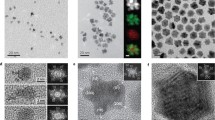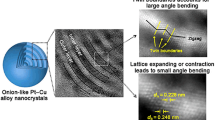Abstract
Nanoscale Kirkendall effect has been widely used for rationally fabricating high-quality hollow nanocrystals, but often requires the intrinsic diffusion coefficient of out-diffusion materials higher than that of in-diffusion components. Here we demonstrate an unexpected Kirkendall effect that occurs in diffusing intrinsically faster Cu atoms into Pd icosahedra, leading to the formation of PdCu alloyed hollow nanocrystals. The control experiment with Pd octahedra replacing icosahedra indicates the critical role of twin boundaries in facilitating such unexpected Kirkendall effect. In addition, geometric phase analysis and density functional theory calculation show that out-diffusion of Pd atoms in the icosahedra is faster than in-diffusion of Cu atoms, particularly through the twin boundaries, upon the strain gradient with an inward distribution from tensile to compressive strains. The unexpected Kirkendall effect is also found in the interdiffusion of Ag and Pd atoms in Pd icosahedra. Our finds break the limitation of the intrinsic diffusion coefficient for the synthesis of hollow nanocrystals through Kirkendall effect and are expected to enormously enrich the family of hollow nanocrystals which have shown great potential in broad areas, such as fine chemical production, energy storage and conversion, and environmental protection. This work also provides a deep understanding in the diffusion behavior of atoms upon the strain gradient.

Similar content being viewed by others
References
Smigelskas, A. D.; Kirkendall, E. O. Zinc diffusion in alpha brass. Trans. AIME1947, 171, 130–142.
Kirkendall, E. O. Diffusion of zinc in alpha brass. Trans. AIME1942, 147, 104–110.
Yin, Y. D.; Rioux, R. M.; Erdonmez, C. K.; Hughes, S.; Somorjai, G. A.; Alivisatos, A. P. Formation of hollow nanocrystals through the nanoscale Kirkendall effect. Science2004, 304, 711–714.
Fan, H. J.; Knez, M.; Scholz, R.; Nielsch, K.; Pippel, E.; Hesse, D.; Zacharias, M.; Gösele, U. Monocrystalline spinel nanotube fabrication based on the Kirkendall effect. Nat. Mater.2006, 5, 627–631.
Chen, C.; Kang, Y. J.; Huo, Z. Y.; Zhu, Z. W.; Huang, W. Y.; Xin, H. L.; Snyder, J. D.; Li, D. G.; Herron, J. A.; Mavrikakis, M. et al. Highly crystalline multimetallic nanoframes with three-dimensional electrocatalytic surfaces. Science2014, 343, 1339–1343.
González, E.; Arbiol, J.; Puntes, V. F. Carving at the nanoscale: Sequential galvanic exchange and kirkendall growth at room temperature. Science2011, 334, 1377–1380.
Fan, H. J.; Gösele, U.; Zacharias, M. Formation of nanotubes and hollow nanoparticles based on Kirkendall and diffusion processes: A review. Small2007, 3, 1660–1671.
Fan, H. J.; Yang, Y.; Zacharias, M. ZnO-based ternary compound nanotubes and nanowires. J. Mater. Chem.2009, 19, 885–900.
Chou, N. H.; Schaak, R. E. Shape-controlled conversion of β-Sn nanocrystals into intermetallic M-Sn (M = Fe, Co, Ni, Pd) nanocrystals. J. Am. Chem. Soc.2007, 129, 7339–7345.
He, T. O.; Wang, W. C.; Yang, X. L.; Cao, Z. M.; Kuang, Q.; Wang, Z.; Shan, Z. W.; Jin, M. S.; Yin, Y. D. Inflating hollow nanocrystals through a repeated Kirkendall cavitation process. Nat. Commun.2017, 8, 1261.
Jana, S.; Chang, J. W.; Rioux, R. M. Synthesis and modeling of hollow intermetallic Ni-Zn nanoparticles formed by the Kirkendall effect. Nano Lett.2013, 13, 3618–3625.
Niu, K. Y.; Park, J.; Zheng, H. M.; Alivisatos, A. P. Revealing bismuth oxide hollow nanoparticle formation by the Kirkendall effect. Nano Lett.2013, 13, 5715–5719.
Peng, S.; Sun, S. H. Synthesis and characterization of monodisperse hollow Fe3O4 nanoparticles. Angew. Chem., Int. Ed.2007, 46, 4155–4158.
Yin, Y.; Erdonmez, C. K.; Cabot, A.; Hughes, S.; Alivisatos, A. P. Colloidal synthesis of hollow cobalt sulfide nanocrystals. Adv. Funct. Mater.2006, 16, 1389–1399.
Wang, Y.; Cai, L.; Xia, Y. Monodisperse spherical colloids of Pb and their use as chemical templates to produce hollow particles. Adv. Mater.2005, 17, 473–477.
Henkes, A. E.; Vasquez, Y.; Schaak, R. E. Converting metals into phosphides: A general strategy for the synthesis of metal phosphide nanocrystals. J. Am. Chem. Soc.2007, 129, 1896–1897.
Feng, J. R.; Lv, F.; Zhang, W. Y.; Li, P. H.; Wang, K.; Yang, C.; Wang, B.; Yang, Y.; Zhou, J. H.; Lin, F. et al. Iridium-based multimetallic porous hollow nanocrystals for efficient overall-water-splitting catalysis. Adv. Mater.2017, 29, 1703798.
Zhang, L.; Roling, L. T.; Wang, X.; Vara, M.; Chi, M. F.; Liu, J. Y.; Choi, S. I.; Park, J.; Herron, J. A.; Xie, Z. X. et al. Platinum-based nanocages with subnanometer-thick walls and well-defined, controllable facets. Science2015, 349, 412–416.
Yan, K.; Lu, Z. D.; Lee, H. W.; Xiong, F.; Hsu, P. C.; Li, Y. Z.; Zhao, J.; Chu, S.; Cui, Y. Selective deposition and stable encapsulation of lithium through heterogeneous seeded growth. Nat. Energy2016, 1, 16010.
Ren, H.; Yu, R. B.; Wang, J. Y.; Jin, Q.; Yang, M.; Mao, D.; Kisailus, D.; Zhao, H. J.; Wang, D. Multishelled TiO2 hollow microspheres as anodes with superior reversible capacity for lithium ion batteries. Nano Lett.2014, 14, 6679–6684.
Chen, Y.; Li, W. Z.; Wang, J. Y.; Gan, Y. L.; Liu, L.; Ju, M. T. Microwave-assisted ionic liquid synthesis of Ti3+ self-doped TiO2 hollow nanocrystals with enhanced visible-light photoactivity. Appl. Catal. B Environ.2016, 191, 94–105.
Yang, X.; Gilroy, K. D.; Vara, M.; Zhao, M.; Zhou, S.; Xia, Y. N. Gold icosahedral nanocages: Facile synthesis, optical properties, and fragmentation under ultrasonication. Chem. Phys. Lett.2017, 683, 613–618.
Zhang, H.; Zhu, Q.; Zhang, Y.; Wang, Y.; Zhao, L.; Yu, B. One-pot synthesis and hierarchical assembly of hollow Cu2O microspheres with nanocrystals-composed porous multishell and their gas-sensing properties. Adv. Funct. Mater.2007, 17, 2766–2771.
Shevchenko, E. V.; Bodnarchuk, M. I.; Kovalenko, M. V.; Talapin, D. V.; Smith, R. K.; Aloni, S.; Heiss, W.; Alivisatos, A. P. Gold/iron oxide core/hollow-shell nanoparticles. Adv. Mater.2008, 20, 4323–4329.
Cai, X. J.; Gao, W.; Ma, M.; Wu, M. Y.; Zhang, L. L.; Zheng, Y. Y.; Chen, H. R.; Shi, J. L. A prussian blue-based core-shell hollow-structured mesoporous nanoparticle as a smart theranostic agent with ultrahigh pH-responsive longitudinal relaxivity. Adv. Mater.2015, 27, 6382–6389.
Darken, L. S. Diffusion, mobility and their interrelation through free energy in binary metallic systems. Trans. AIME1948, 175, 184–201.
Masumura, R. A.; Rath, B. B.; Pande, C. S. Analysis of Cu-Ni diffusion in a spherical geometry for excess vacancy production. Acta Mater.2002, 50, 4535–4544.
Schröder, H.; Samwer, K.; Köster, U. Micromechanism for metallic-glass formation by solid-state reactions. Phys. Rev. Lett.1985, 54, 197–200.
Zeng, K. J.; Stierman, R.; Chiu, T. C.; Edwards, D.; Ano, K.; Tu, K. N. Kirkendall void formation in eutectic SnPb solder joints on bare Cu and its effect on joint reliability. J. Appl. Phys.2005, 97, 024508.
Tu, K. N.; Gösele, U. Hollow nanostructures based on the Kirkendall effect: Design and stability considerations. Appl. Phys. Lett.2005, 86, 093111.
Wang, C. M.; Baer, D. R.; Thomas, L. E.; Amonette, J. E.; Antony, J.; Qiang, Y.; Duscher, G. Void formation during early stages of passivation: Initial oxidation of iron nanoparticles at room temperature. J. Appl. Phys.2005, 98, 094308.
Nakamura, R.; Lee, J. G.; Tokozakura, D.; Mori, H.; Nakajima, H. Formation of hollow ZnO through low-temperature oxidation of Zn nanoparticles. Mater. Lett.2007, 61, 1060–1063.
Nakamura, R.; Tokozakura, D.; Nakajima, H.; Lee, J. G.; Mori, H. Hollow oxide formation by oxidation of Al and Cu nanoparticles. J. Appl. Phys.2007, 101, 074303.
Pratt, A.; Lari, L.; Hovorka, O.; Shah, A.; Woffinden, C.; Tear, S. P.; Binns, C.; Kröger, R. Enhanced oxidation of nanoparticles through strain-mediated ionic transport. Nat. Mater.2014, 13, 26–30.
Marks, L. D.; Howie, A. Multiply-twinned particles in silver catalysts. Nature1979, 282, 196–198.
Howie, A.; Marks, L. D. Elastic strains and the energy balance for multiply twinned particles. Philos. Mag. A1984, 49, 95–109.
Wang, H. L.; Zhou, S.; Gilroy, K. D.; Cai, Z. S.; Xia, Y. N. Icosahedral nanocrystals of noble metals: Synthesis and applications. Nano Today2017, 15, 121–144.
Jin, M. S.; Zhang, H.; Xie, Z. X.; Xia, Y. N. Palladium nanocrystals enclosed by {100} and {111} facets in controlled proportions and their catalytic activities for formic acid oxidation. Energy Environ. Sci.2012, 5, 6352–6357.
Strasser, P.; Koh, S.; Anniyev, T.; Greeley, J.; More, K.; Yu, C. F.; Liu, Z. C.; Kaya, S.; Nordlund, D.; Ogasawara, H. et al. Lattice-strain control of the activity in dealloyed core-shell fuel cell catalysts. Nat. Chem.2010, 2, 454–460.
Brown, A. M.; Ashby, M. F. Correlations for diffusion constants. Acta Metall.1980, 28, 1085–1101.
Chakraborty, J.; Welzel, U.; Mittemeijer, E. J. Interdiffusion, phase formation, and stress development in Cu-Pd thin-film diffusion couples: Interface thermodynamics and mechanisms. J. Appl. Phys.2008, 103, 113512.
Chakraborty, J.; Welzel, U.; Mittemeijer, E. J. Mechanisms of interdiffusion in Pd-Cu thin film diffusion couples. Thin Solid Films2010, 518, 2010–2020.
Lou, X. W.; Archer, L. A.; Yang, Z. C. Hollow micro-/nanostructures: Synthesis and applications. Adv. Mater.2008, 20, 3987–4019.
Wang, M.; Zhang, W. M.; Wang, J. Z.; Minett, A.; Lo, V.; Liu, H. K.; Chen, J. Mesoporous hollow PtCu nanoparticles for electrocatalytic oxygen reduction reaction. J. Mater. Chem. A2013, 1, 2391–2394.
Wang, C.; Sui, Y. M.; Xu, M.; Liu, C.; Xiao, G. J.; Zou, B. Synthesis of Ni-Ir nanocages with improved electrocatalytic performance for the oxygen evolution reaction. ACS Sustainable Chem. Eng.2017, 5, 9787–9792.
Zhang, C. H.; Liu, Y.; Chang, Y. X.; Lu, Y. N.; Zhao, S. L.; Xu, D. D.; Dai, Z. H.; Han, M.; Bao, J. C. Component-controlled synthesis of necklace-like hollow NixRuy nanoalloys as electrocatalysts for hydrogen evolution reaction. ACS Appl. Mater. Interfaces2017, 9, 17326–17336.
Porter, D. A.; Easterling, K. E.; Sherif, M. Y. Phase Transformations in Metals and Alloys; 3rd ed. CRC Press, Boca Raton, 2009; pp 96–98.
Yang, C. Y. Crystallography of decahedral and icosahedral particles: I. geometry of twinning. J. Cryst. Growth1979, 47, 274–282.
Marks, L. D.; Peng, L. Nanoparticle shape, thermodynamics and kinetics. J. Phys.: Condens. Matter2016, 28, 053001.
Johnson, C. L.; Snoeck, E.; Ezcurdia, M.; Rodríguez-González, B.; Pastoriza-Santos, I.; Liz-Marzán, L. M.; Hytch, M. J. Effects of elastic anisotropy on strain distributions in decahedral gold nanoparticles. Nat. Mater.2008, 7, 120–124.
Ji, W. H.; Qi, W. H.; Li, X.; Zhao, S. L.; Tang, S. S.; Peng, H. C.; Li, S. Q. Investigation of disclinations in Marks decahedral Pd nanoparticles by aberration-corrected HRTEM. Mater. Lett.2015, 152, 283–286.
Peng, L. X.; Van Duyne, R. P.; Marks, L. D. Strain-induced segregation in bimetallic multiply twinned particles. J. Phys. Chem. Lett.2015, 6, 1930–1934.
Hytch, M. J.; Snoeck, E.; Kilaas, R. Quantitative measurement of displacement and strain fields from HREM micrographs. Ultramicroscopy1998, 74, 131–146.
Goris, B.; De Beenhouwer, J.; De Backer, A.; Zanaga, D.; Batenburg, K. J.; Sánchez-Iglesias, A.; Liz-Marzán, L. M.; Van Aert, S.; Bals, S.; Sijbers, J. et al. Measuring lattice strain in three dimensions through electron microscopy. Nano Lett.2015, 15, 6996–7001.
Xi, Z.; Cheng, X.; Gao, Z. Q.; Wang, M. J.; Cai, T.; Muzzio, M.; Davidson, E.; Chen, O.; Jung, Y.; Sun, S. H. et al. Strain effect in palladium nanostructures as nanozymes. Nano Lett.2020, 20, 272–277.
Fan, H. J.; Knez, M.; Scholz, R.; Hesse, D.; Nielsch, K.; Zacharias, M.; Gösele, U. Influence of surface diffusion on the formation of hollow nanostructures induced by the Kirkendall effect: The basic concept. Nano Lett.2007, 7, 993–997.
Sun, Y. G.; Zuo, X. B.; Sankaranarayanan, S. K. R. S.; Peng, S.; Narayanan, B.; Kamath, G. Quantitative 3D evolution of colloidal nanoparticle oxidation in solution. Science2017, 356, 303–307.
Perdew, J. P.; Burke, K.; Ernzerhof, M. Generalized gradient approximation made simple. Phys. Rev. Lett.1996, 77, 3865–3868.
Acknowledgements
This work was supported by the National Science Foundation of China (Nos. 51522103, 51871200, and 61721005) and the National Program for Support of Top-Notch Young Professionals.
Author information
Authors and Affiliations
Corresponding authors
Electronic Supplementary Material
Rights and permissions
About this article
Cite this article
Huang, J., Yan, Y., Li, X. et al. Unexpected Kirkendall effect in twinned icosahedral nanocrystals driven by strain gradient. Nano Res. 13, 2641–2649 (2020). https://doi.org/10.1007/s12274-020-2903-9
Received:
Revised:
Accepted:
Published:
Issue Date:
DOI: https://doi.org/10.1007/s12274-020-2903-9




